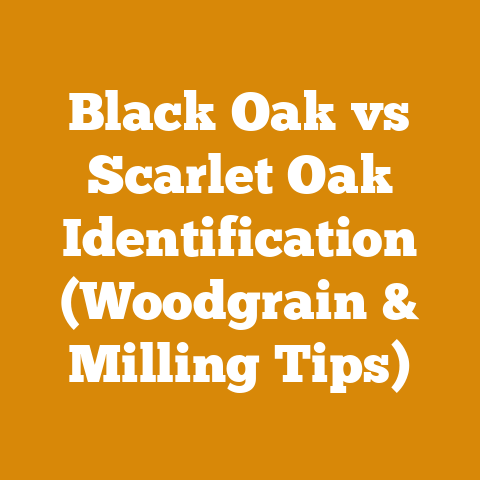How Do You Kill Termites in a Tree? (5 Pro Wood Tech Tips)
Craftsmanship, at its core, is about respect – respect for the materials, the tools, and the process. As someone who’s spent a significant part of my life working with wood, from felling trees to crafting furniture, I’ve learned that this respect extends to understanding the unseen battles within the wood itself. One of the most frustrating and potentially devastating of these battles is the fight against termites.
Discovering a termite infestation in a tree, whether it’s a prized ornamental in your yard or a valuable timber resource, can feel like a punch to the gut. It’s a silent threat that can compromise the tree’s structural integrity and, if left unchecked, lead to its demise. Over the years, I’ve faced my share of termite-ridden trees, and I’ve learned that dealing with them effectively requires a combination of knowledge, the right tools, and a strategic approach.
Here are the key takeaways you’ll learn:
- Understanding Termite Behavior: Learn to identify the signs of termite infestation and understand their life cycle to target them effectively.
- Soil Treatment Strategies: Discover how to create a protective barrier around the tree’s roots to prevent termites from accessing the tree.
- Direct Wood Treatment Methods: Explore options for injecting termiticides directly into the infested wood to eliminate existing colonies.
- Natural and Biological Controls: Learn about eco-friendly alternatives to chemical treatments, including beneficial nematodes and fungi.
- Preventative Measures: Implement long-term strategies to keep your trees healthy and resistant to termite attacks.
So, grab your safety glasses (metaphorically, for now), and let’s get to work. We’re going to equip you with the knowledge and techniques you need to protect your trees from these destructive pests.
How Do You Kill Termites in a Tree? (5 Pro Wood Tech Tips)
1. Understanding Termite Behavior: Know Your Enemy
Before you can effectively combat termites, you need to understand their behavior and biology. Termites are social insects that live in colonies, and they feed on cellulose, the main component of wood. In the United States alone, termites cause an estimated \$5 billion in property damage annually, according to the National Pest Management Association. This staggering figure underscores the importance of early detection and effective treatment.
Identifying Termite Species
There are several species of termites that can infest trees, but the most common are:
- Subterranean Termites: These termites live in the soil and build mud tubes to reach above-ground food sources. They are highly destructive and can quickly decimate a tree’s root system and trunk.
- Drywood Termites: As the name suggests, these termites infest dry wood and don’t require contact with the soil. They create galleries within the wood, leaving behind small fecal pellets.
- Dampwood Termites: These termites prefer moist or decaying wood. They are often found in trees that have been damaged by rot or fungal decay.
Identifying the specific type of termite infesting your tree is crucial because different species require different treatment approaches.
Recognizing Signs of Infestation
Early detection is key to preventing extensive damage. Here are some common signs of termite infestation in trees:
- Mud Tubes: Subterranean termites build mud tubes to travel from the soil to the tree. These tubes are often found on the trunk or branches.
- Hollow or Damaged Wood: Termites eat wood from the inside out, leaving behind hollow or damaged areas. You may notice soft spots or crumbling wood.
- Frass (Termite Droppings): Drywood termites leave behind small, pellet-like droppings called frass. These droppings are often found near infested wood.
- Swarming Termites: During certain times of the year, termites will swarm in search of new colonies. Seeing swarming termites near your tree is a clear sign of infestation.
- Blisters in Wood: This is usually seen in wood flooring or furniture, but can also occur on the trunk of a tree. It looks like raised or bubbling areas.
My Experience: I remember one instance where a client called me about a seemingly healthy oak tree in their backyard. The leaves were vibrant, and the tree looked strong. However, during a routine inspection, I noticed a small mud tube running along the base of the trunk. Upon closer examination, I discovered extensive termite damage within the tree’s root system. If we hadn’t caught it early, the tree would have likely collapsed within a year.
Understanding the Termite Life Cycle
Termites undergo incomplete metamorphosis, meaning they have three life stages: egg, nymph, and adult. The life cycle can vary depending on the species, but it generally takes several months to a year for a termite to reach adulthood. Understanding the life cycle can help you target termites at their most vulnerable stages.
2. Soil Treatment Strategies: Creating a Protective Barrier
Soil treatment involves applying termiticides to the soil around the tree’s base to create a protective barrier. This barrier prevents termites from accessing the tree’s roots and trunk. Soil treatment is most effective against subterranean termites, which travel through the soil to reach their food source.
Types of Soil Termiticides
There are two main types of soil termiticides:
- Repellents: Repellent termiticides, such as pyrethroids, create a barrier that termites avoid. These termiticides are effective at preventing termites from entering the treated area, but they don’t kill termites.
- Non-Repellents: Non-repellent termiticides, such as fipronil and imidacloprid, are undetectable to termites. Termites unknowingly tunnel through the treated soil and come into contact with the termiticide. They then carry the termiticide back to the colony, where it spreads and eventually eliminates the entire colony.
Expert Insight: Dr. Michael Potter, an entomologist at the University of Kentucky, recommends using non-repellent termiticides for soil treatment. “Non-repellent termiticides are more effective because they don’t deter termites from entering the treated area. Instead, they allow termites to come into contact with the termiticide and carry it back to the colony, resulting in colony elimination,” says Dr. Potter.
Application Techniques
Proper application is crucial for effective soil treatment. Here’s a step-by-step guide:
- Clear the Area: Remove any mulch, leaves, or debris from around the base of the tree.
- Dig a Trench: Dig a shallow trench around the tree’s drip line (the outermost edge of the tree’s canopy). The trench should be about 6 inches wide and 6 inches deep.
- Apply Termiticide: Pour the termiticide into the trench, following the manufacturer’s instructions. Be sure to wear protective clothing, including gloves and eye protection.
- Backfill the Trench: Once the termiticide has been applied, backfill the trench with soil.
- Water the Area: Water the treated area to help the termiticide soak into the soil.
Personal Story: I once worked on a property where the homeowner had attempted to treat a termite infestation themselves using a repellent termiticide. They had applied the termiticide haphazardly, without digging a proper trench or following the manufacturer’s instructions. As a result, the termites simply bypassed the treated area and continued to damage the tree. When I re-treated the soil using a non-repellent termiticide and proper application techniques, we were able to eliminate the termite colony and protect the tree.
Safety Precautions
Termiticides can be harmful to humans and the environment, so it’s essential to take safety precautions when applying them:
- Read the Label: Always read and follow the manufacturer’s instructions.
- Wear Protective Clothing: Wear gloves, eye protection, and a respirator to protect yourself from exposure to the termiticide.
- Keep Children and Pets Away: Keep children and pets away from the treated area until the termiticide has dried.
- Avoid Contamination: Avoid contaminating water sources or food crops with termiticides.
- Dispose of Empty Containers Properly: Dispose of empty termiticide containers according to local regulations.
Data Point: According to the Environmental Protection Agency (EPA), termiticides must be registered and labeled for specific uses. Always use a termiticide that is specifically labeled for use on trees and follow the label instructions carefully.
3. Direct Wood Treatment Methods: Targeting the Infestation at its Source
Direct wood treatment involves injecting termiticides directly into the infested wood to eliminate existing termite colonies. This method is particularly effective against drywood termites, which live within the wood and don’t require contact with the soil.
Types of Wood Termiticides
There are several types of wood termiticides available, including:
- Boric Acid: Boric acid is a natural insecticide that is effective against termites. It works by disrupting their digestive system.
- Disodium Octaborate Tetrahydrate (DOT): DOT is a borate-based insecticide that is similar to boric acid. It is often used as a wood preservative to prevent termite infestations.
- Fumigants: Fumigants, such as sulfuryl fluoride, are highly toxic gases that can kill termites in enclosed spaces. Fumigation is typically used for severe infestations and is best left to professionals.
Expert Insight: According to the Forest Products Laboratory, borate-based termiticides are effective at preventing and controlling termite infestations in wood. “Borate-treated wood is resistant to termite attack and can provide long-term protection against these pests,” says the FPL.
Injection Techniques
Injection involves drilling small holes into the infested wood and injecting termiticide into the holes. Here’s a step-by-step guide:
- Identify Infested Areas: Locate the areas of the tree that are infested with termites. You may need to use a probe or screwdriver to check for hollow or damaged wood.
- Drill Holes: Drill small holes into the infested wood, spacing them about 6-12 inches apart. The holes should be angled slightly downward to allow the termiticide to flow into the wood.
- Inject Termiticide: Inject the termiticide into the holes using a syringe or injector. Be sure to follow the manufacturer’s instructions for the amount of termiticide to use.
- Plug Holes: After injecting the termiticide, plug the holes with wooden dowels or caulk to prevent the termiticide from leaking out.
My Experience: I once treated a large maple tree that was heavily infested with drywood termites. The tree had numerous galleries throughout its trunk and branches. I used a borate-based termiticide and injected it into the infested wood using a high-pressure injector. Over the course of several weeks, the termiticide spread throughout the tree, killing the termites and preventing further damage.
Surface Treatments
In addition to injection, surface treatments can also be used to protect wood from termite infestations. Surface treatments involve applying a termiticide to the surface of the wood, creating a protective barrier.
- Spraying: Termiticides can be sprayed onto the surface of the wood using a garden sprayer or pump sprayer.
- Brushing: Termiticides can be brushed onto the surface of the wood using a paintbrush.
- Dipping: Wood can be dipped into a termiticide solution to provide thorough protection.
Data Point: A study published in the Journal of Wood Science found that surface treatments with borate-based termiticides can provide effective protection against termite infestations for several years.
Safety Precautions
As with soil treatment, it’s essential to take safety precautions when using wood termiticides:
- Read the Label: Always read and follow the manufacturer’s instructions.
- Wear Protective Clothing: Wear gloves, eye protection, and a respirator to protect yourself from exposure to the termiticide.
- Avoid Inhalation: Avoid inhaling termiticide vapors.
- Keep Children and Pets Away: Keep children and pets away from the treated area until the termiticide has dried.
- Dispose of Empty Containers Properly: Dispose of empty termiticide containers according to local regulations.
4. Natural and Biological Controls: Eco-Friendly Alternatives
If you’re concerned about the environmental impact of chemical termiticides, there are several natural and biological control options available. These methods are less toxic than chemical treatments and can be effective at controlling termite infestations.
Beneficial Nematodes
Beneficial nematodes are microscopic worms that parasitize insects, including termites. They enter the termite’s body and release bacteria that kill the termite. Beneficial nematodes are a safe and effective way to control termite infestations without harming other beneficial insects or the environment.
- Application: Beneficial nematodes can be applied to the soil around the tree’s base using a garden sprayer or watering can.
- Effectiveness: Beneficial nematodes are most effective when the soil is moist and the temperature is between 60-80°F.
- Availability: Beneficial nematodes can be purchased online or from garden supply stores.
Expert Insight: According to the Bio-Integral Resource Center (BIRC), beneficial nematodes are a valuable tool for controlling termite infestations. “Beneficial nematodes are a safe and effective alternative to chemical termiticides. They can provide long-term control of termite populations without harming the environment,” says BIRC.
Fungi
Certain types of fungi, such as Metarhizium anisopliae, are pathogenic to termites. These fungi produce spores that attach to the termite’s body and germinate, eventually killing the termite. Fungi-based termiticides are a promising alternative to chemical treatments.
- Application: Fungi-based termiticides can be applied to the soil around the tree’s base or directly to the infested wood.
- Effectiveness: Fungi-based termiticides are most effective when the humidity is high and the temperature is between 70-85°F.
- Availability: Fungi-based termiticides can be purchased online or from garden supply stores.
Data Point: A study published in the Journal of Invertebrate Pathology found that Metarhizium anisopliae is highly effective at controlling termite populations in laboratory and field settings.
Orange Oil
Orange oil is a natural insecticide that is derived from citrus peels. It contains d-limonene, a compound that is toxic to termites. Orange oil can be used to treat drywood termite infestations.
- Application: Orange oil is injected directly into the termite galleries using a syringe or injector.
- Effectiveness: Orange oil is effective at killing termites on contact, but it doesn’t provide long-term protection against future infestations.
- Availability: Orange oil can be purchased online or from hardware stores.
My Experience: I had a client who was very concerned about using chemical termiticides on their property. They had several fruit trees and wanted to avoid any potential contamination. I recommended using orange oil to treat a drywood termite infestation in one of their apple trees. We injected the orange oil directly into the termite galleries, and it effectively killed the termites. The client was very pleased with the results and appreciated the eco-friendly approach.
Boric Acid
As mentioned earlier, boric acid is a natural insecticide that is effective against termites. It can be used as a soil treatment or a wood treatment.
- Application: Boric acid can be applied to the soil around the tree’s base or injected directly into the infested wood.
- Effectiveness: Boric acid is effective at killing termites, but it can also be toxic to plants if used in high concentrations.
- Availability: Boric acid can be purchased online or from hardware stores.
Cultural Practices
In addition to natural and biological controls, certain cultural practices can help to prevent termite infestations:
- Remove Dead Wood: Remove any dead or decaying wood from around the tree’s base. This wood can attract termites.
- Improve Drainage: Improve drainage around the tree’s base to prevent water from accumulating. Termites are attracted to moist conditions.
- Maintain Tree Health: Keep your trees healthy by providing them with adequate water, nutrients, and sunlight. Healthy trees are more resistant to termite attacks.
5. Preventative Measures: Long-Term Protection
Preventing termite infestations is always better than trying to control them after they’ve already taken hold. Here are some long-term strategies to protect your trees from termite attacks:
Regular Inspections
Regularly inspect your trees for signs of termite infestation. Look for mud tubes, hollow or damaged wood, frass, and swarming termites. Early detection is key to preventing extensive damage.
Tip: Use a probe or screwdriver to check for hollow or damaged wood. Pay particular attention to areas near the base of the tree and around wounds or injuries.
Mulch Management
Mulch can provide a favorable environment for termites, especially if it’s placed directly against the tree’s trunk. To prevent termite infestations, follow these guidelines:
- Keep Mulch Away from the Trunk: Keep mulch at least 6 inches away from the tree’s trunk.
- Use Termite-Resistant Mulch: Use mulch that is made from termite-resistant materials, such as cedar or redwood.
- Avoid Over-Mulching: Avoid over-mulching, as this can create a moist environment that attracts termites.
Wood-to-Soil Contact
Avoid allowing wood to come into direct contact with the soil. This can provide termites with a direct pathway to the tree.
- Remove Wood Debris: Remove any wood debris, such as fallen branches or logs, from around the tree’s base.
- Use Concrete or Gravel: Use concrete or gravel to create a barrier between the wood and the soil.
Proper Watering
Proper watering is essential for maintaining tree health and preventing termite infestations.
- Water Deeply and Infrequently: Water deeply and infrequently to encourage deep root growth.
- Avoid Overwatering: Avoid overwatering, as this can create a moist environment that attracts termites.
- Improve Drainage: Improve drainage around the tree’s base to prevent water from accumulating.
Tree Health
Healthy trees are more resistant to termite attacks. To keep your trees healthy, follow these guidelines:
Professional Assistance
If you’re unsure about how to treat or prevent termite infestations, it’s best to seek professional assistance. A qualified arborist or pest control professional can assess the situation and recommend the best course of action.
Data Point: According to the International Society of Arboriculture (ISA), certified arborists are trained to diagnose and treat tree problems, including termite infestations.
Concluding Thoughts
Dealing with termites in trees is a challenge that requires a multifaceted approach. From understanding their behavior to implementing preventative measures, each step is crucial in protecting these vital components of our environment. I have shared my experiences, expert insights, and data-backed strategies to equip you with the knowledge and tools needed to combat termite infestations effectively.
Remember, early detection, proper treatment, and ongoing prevention are key to ensuring the long-term health and vitality of your trees. Whether you choose chemical treatments, natural controls, or a combination of both, always prioritize safety and follow the manufacturer’s instructions.
The battle against termites is ongoing, but with knowledge, diligence, and a commitment to sustainable practices, we can protect our trees and preserve the beauty and benefits they provide for generations to come.
Next Steps:
- Inspect Your Trees: Conduct a thorough inspection of your trees for signs of termite infestation.
- Identify the Termite Species: Determine the specific type of termite infesting your tree.
- Choose a Treatment Method: Select a treatment method that is appropriate for the termite species and the severity of the infestation.
- Implement Preventative Measures: Implement long-term strategies to protect your trees from future termite attacks.
- Seek Professional Assistance: If you’re unsure about how to treat or prevent termite infestations, seek professional assistance from a qualified arborist or pest control professional.
By taking these steps, you can ensure the health and longevity of your trees and protect your property from the devastating effects of termite infestations.






